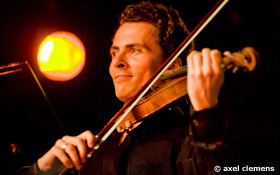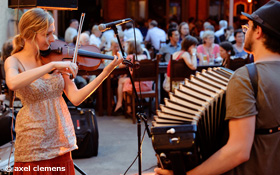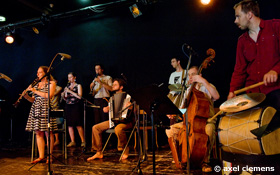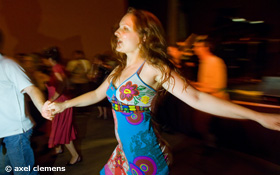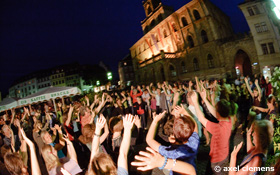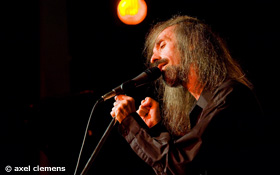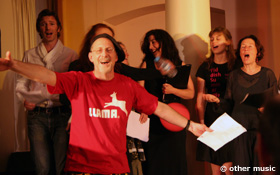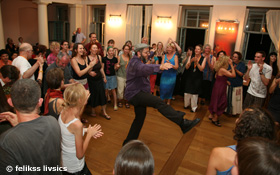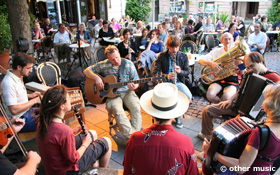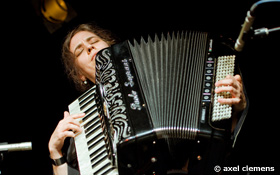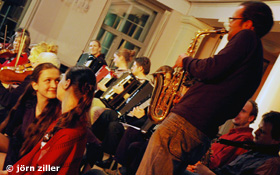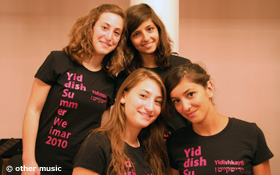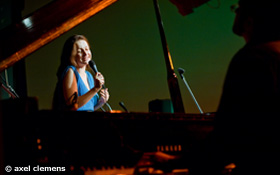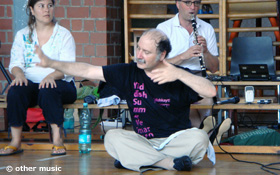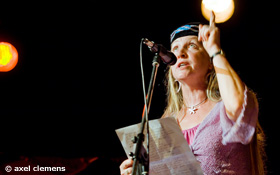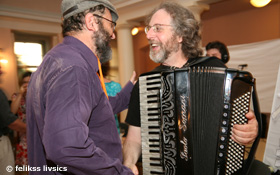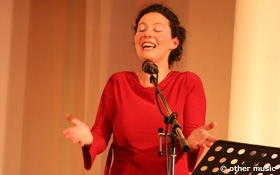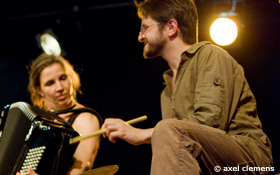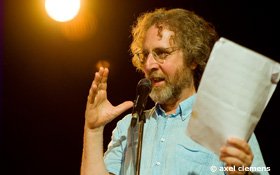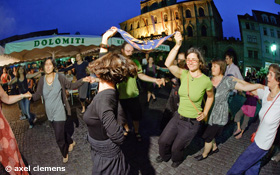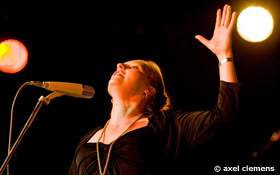Symposium
The Matrix of Yiddish & German Cultures | Die Matrix deutsch-jiddischer Kulturen
JULY 17
Welcome & Introduction
09:30 - 10:30 Arrival, gathering
10:30 - 11:15 Symposium opening: greetings & introductions
Session 1: Reception of klezmer music in Germany | Die Rezeption von Klezmermusik in Deutschland
11:15 - 11:45
"Giora Feidman in Germany" „Giora Feidman in Deutschland” Alina Bauer read more 
Session 1: Reception of klezmer music in Germany | Die Rezeption von Klezmermusik in Deutschland
11:15 - 11:45
"Giora Feidman in Germany" „Giora Feidman in Deutschland” Alina Bauer
In the course of his 25-year career, Giora Feidman, the “King of Klezmer,” played a role in the German/Jewish discourse on overcoming the past, and in this sense also acted as a political instrument. This talk seeks to account for this development through an analysis of Feidman’s representation of himself and others and a sketch of social relations in Germany in the 1990s. back 
11:45 - 12:15
"With an Open Mind and with Respect: Klezmer in Germany in the 2000s" „Unvoreingenommen und mit Respekt: Klezmer im Deutschland der 2000er”
Dr. Joel Rubin read more 
11:45 - 12:15
"With an Open Mind and with Respect: Klezmer in Germany in the 2000s" „Unvoreingenommen und mit Respekt: Klezmer im Deutschland der 2000er”
Dr. Joel Rubin
Despite the significant media attention that klezmer music in Germany has received over the past twenty-five years, little scholarship on the topic has been generated, especially from an ethnomusicological perspective. In both journalistic and scholarly accounts to date, klezmer in Germany has largely been handled as a monolith, with most accounts focusing on socio-political aspects relating to the fact that the majority of the musicians involved are non-Jewish Germans and that the scene serves primarily as a mechanism for Versöhnung (reconciliation) and Vergangenheitsbewältigung (coming to terms with the National Socialist past). Yet so doing obscures the contemporary German klezmer scene as a dynamic movement that has evolved over a more than twenty year period. It comprises participants from numerous backgrounds and generations and also includes Jews from the FSU, Israel and the USA in addition to Germans both non-Jewish and Jewish who came of age in the former GDR as well as West Germany. Another factor is the strong influence of Germahy on the development of klezmer music internationally – in particular in the United States – as well as interesting international collaborations that have developed in recent years. Finally, a differentiation needs to be made between the performance of Yiddish song in post-Holocaust Germany, which had its roots in the immediate postwar period and with limited American involvement, and the performance of instrumental klezmer music in Germany, which first began in the mid-1980s and developed almost entirely under American and Israeli influence. The paper will be based on original ethnographic interviews, a review of the available secondary literature, and the author’s own experiences as a performer-scholar during fifteen years of living and working in Germany. Contemporary German klezmer will be situated within a broader framework, showing that, while issues of the Holocaust, Vergangenheitsbewältigung, Versöhnung, and the building of a post-Cold War German identity are central themes, at the same time a study of the scene can point to new ways of thinking about more nuanced German-Jewish relations and the nature of Jewishness at the beginning of the 21st century, as well as about global music making and marketing in the 21st century, cultural hybridity, post-ethnicity and, perhaps, hyper-ethnicity. back 
12:15 - 13:00 Session 1 discussion
13:00 - 15:00 Lunch
Session 2: Theoretical framework, Ashkenaz 1 & 2 | Theoretischer Rahmen: Max Weinreichs Konzepte „Ashkenaz I” und „Ashkenaz II”
15:00 - 15:30
"Changing Cultural Relations Between Ashkenaz I and Ashkenaz II During the 17th and 18th Centuries—the Case of Instrumental Folk Music" „Sich wandelnde kulturelle Beziehungen zwischen Ashkenaz I und Ashkenaz II während des 17. und 18. Jahrhunderts am Beispiel der instrumentalen Volksmusik”
Prof. Dr. Zev Feldman read more 
Session 2: Theoretical framework, Ashkenaz 1 & 2 | Theoretischer Rahmen: Max Weinreichs Konzepte „Ashkenaz I” und „Ashkenaz II”
15:00 - 15:30
"Changing Cultural Relations Between Ashkenaz I and Ashkenaz II During the 17th and 18th Centuries—the Case of Instrumental Folk Music" „Sich wandelnde kulturelle Beziehungen zwischen Ashkenaz I und Ashkenaz II während des 17. und 18. Jahrhunderts am Beispiel der instrumentalen Volksmusik”
Prof. Dr. Zev Feldman
The scanty evidence concerning instrumental folk music will be examined within the theoretical framework of embedded and transnational Jewish cultures. This musical material will demonstrate aspects of the relative cultural strength of German, Bohemian and Polish-Lithuanian Jewry in this period. back 
15:30 - 16:00
"Music outside the Synagogue in Early Modern Times" „Musik außerhalb der Synagoge in der Frühen Neuzeit” Dr. Diana Matut read more 
15:30 - 16:00
"Music outside the Synagogue in Early Modern Times" „Musik außerhalb der Synagoge in der Frühen Neuzeit” Dr. Diana Matut
This lecture aims at presenting some of the issues related to Jewish music outside the Synagoge from around 1500-1700, among them: What sources do exist? How did musical transfer take place? Where there any ideological obstacles?
It is meant to offer a small glimps into a Jewish world faced with complex political, social and cultural shifts that nevertheless was vibrant and rich in musical expression. back 
16:00 - 16:30 Session 2 discussion
16:30 - 17:00 Day 1 final discussion
17:00 - 19:00 Dinner
19:00 - 19:45
Book presentation: "Pumei, ihr lieben Gesellen…" The Song and Text Collection of an Early Modern Jew. | Buchvorstellung: „Pumei, ihr lieben Gesellen…" Die Lieder- und Textsammlung eines Juden der Frühen Neuzeit Dr. Diana Matut
20:00 - 22:00 Concert: Ensemble Lucidarium Ain neue lid: when Yiddish was young|In der Frühzeit des Jiddischen
The alternation of periods of hostility with those of clemency on the part of the local population, princes and ecclesiastical institutions marked the existence of the Jews who lived in the German-speaking lands from medieval times throughout the Renaissance, and the 16th century was certainly no exception. read more 
The alternation of periods of hostility with those of clemency on the part of the local population, princes and ecclesiastical institutions marked the existence of the Jews who lived in the German-speaking lands from medieval times throughout the Renaissance, and the 16th century was certainly no exception. This continuous cycle of conditioned acceptance, oppression, expulsion (and worse) would not be broken until the enlightenment. Still, despite adversity, there are clear signs of a flourishing cultural tradition, closely entwined with that of the surrounding populations. It was in this era that the seeds of “Yiddishkeit” were sown, of a poetical and musical tradition that has identified an entire people for hundreds of years.
During the 16th Century, favorable conditions in Italy attracted Jews from around Europe, while the relatively peaceful situation in Eastern Europe led to the first major Ashkenazy Diaspora, that would spread this German dialect written in Hebrew letters throughout Europe, so that books printed in Krakow, Amsterdam and Metz were sold in Prague and Lublin; and Yiddish literary works written in Venice became popular in Lithuania and the Ukraine.
At the same time, the founding of the Lutheran Church and the changes in the Catholic religion both before and after the Reformation brought upon shifting attitudes towards the Jews and their liturgy. One example is the group of Christian Hebraists, closely associated with the Humanist movement, who painstakingly transcribed the liturgical music of the Jews around them, including the Sabbath song “Tzur Mishelo.”
Italy, a haven for Jewish intellectuals, would be a center for Yiddish composition and publishing: in fact, a surprising number of sources, especially from the first 75 or so years of the 16th century, come from Italy. This was a two-way cultural exchange, because at the same time Italian Jewish musicians, such as Abramo dell’Arpa, were in great demand at the German courts. The only known surviving Yiddish-Italian song from the Renaissance was copied in Venice. “Di’ Mensch Geglikhn,” (Man Compared.) It follows Man’s progress through the life cycle, comparing him to a different creature at every stage, from a king (all do his bidding) at birth, to a mouse (bald and slimy) at 100.
In the small South German towns where Church and Synagogue were sometimes separated only by a tavern, Jews and Christians probably used the same music for dancing and celebrations. Jewish musicians played for Christian weddings, as Jewish musicians played for gentile ones. Indeed, the many documents issued by civic and ecclesiastical authorities against intermingling during festive occasions, (especially dancing between Jews and Gentiles) prove just how common it was.
A surprising amount of the liturgical music and folk songs transcribed by Abraham Idelsohn at the turn of the 20th century bears strong traces of Renaissance music. Jewish liturgical melodies are not written down like Gregorian chant. Instead, they are transmitted orally, different for each community, and often changed or substituted as time goes on. This constant flux can also preserve archaic traits: for example: “Mo’oz Tzur,” sung at Chanukah, and probably based on the Lutheran chorale “Nun freut ich liebe Christen g’mein,” while “Eli Tziyon” is almost identical to a “corrente” from a Giuseppe Baldano’s 1602 collection for sordellino (a two chanter bagpipe:) still another reflection of the musical interaction between Jew and Gentile in Renaissance Germany.
The close relationship of the German-speaking Jewry with those around them is further underscored by the contents of one of the important manuscripts of German songs written in Hebrew characters, probably compiled by Eisak Wallich of Wurms at the end of the 16th century. The bulk of its almost 60 songs are drawn from the “greatest hits” of the era (like Di’ Fisch in waser wonen) although adapted for a Jewish audience. The rest of the repertoire is made up of psalms (practically identical to their Lutheran settings) as well as devotional works, satire, epic poetry, songs for Purim and weddings. The ballads found here are drawn from the European collective folk heritage: nonsense songs (like Azo wil ikh zing’n un vil nit ligin), or songs about Love’s perils (Ikh ging bei ain’r nokht.) These are close in imagery and poetic form (although not in melody) to the Yiddish songs performed in Eastern Europe some 300 years later. Next to these “mainstream” pieces, there are more specifically Jewish ones, such as “Min Hametzar: ikh tu anrufen got,” which combines German-Jewish translation and commentary with selections from the Hebrew original of Psalm 118.
Many of the musical models for the Wallich manuscript are found in a collection of lute pieces transcribed by Phillip Hainhofer, a German diplomat, for his personal use. Here too, one finds the “Greatest Hits” of the German, Italian, and French repertoires, once more illustrating the constant musical exchange that went on in 16th Century Europe. Like Giuseppe Balsano’s 1602 source for sordellino, it is full of errors and very sloppily copied: a kind of sketchbook in tablature. One is a German intellectual’s musical souvenir book, the other a hack’s fake book for accompanying dancers: both seem more closely tied to the oral tradition than to the written one, and in fact, some of the dance pieces found in them survived in the popular tradition until the last century. Although these are flawed sources, they offer us a priceless glimpse of the kind of dances and simple songs a typical urban middle class (and, judging from the linked sources, sometimes Jewish) household would have enjoyed in the late 16th century.
This is Yiddish at the beginning of the “fantastic voyage” that would bring it across Eastern Europe and back again. With its pithy humor, biting satire and contemplative moments, it is just as lively, earthy and touching as the Yiddish of yesterday and today. back 
July 18
09:30 - 10:00 Arrival, gathering
Session 3: Research & Performance practice, Early Yiddish song | Forschung und Aufführungspraxis, frühes jiddisches Lied
10:00 - 10:30
"Some Thoughts on Performing Early Jewish music" „Einige Gedanken zur Aufführung früher jüdischer Musik” Avery Gosfield (Enrico Fink, musical examples) read more 
Session 3: Research & Performance practice, Early Yiddish song | Forschung und Aufführungspraxis, frühes jiddisches Lied
10:00 - 10:30
"Some Thoughts on Performing Early Jewish music" „Einige Gedanken zur Aufführung früher jüdischer Musik” Avery Gosfield (Enrico Fink, musical examples)
Until very recently, the field of early Jewish music was essentially limited to Sephardic songs played on historical instruments and the works of Salamone Rossi, although there is a significant number of historical songs texts in early Yiddish, Hebrew, Giudeo-Italian. Transcribed using Hebrew characters and clearly intended for a Jewish audience, these pieces represent an important but largely unknown aspect of Early Modern Jewish culture. Here, we will give a general overview of the available material, and discuss the problems facing those wishing to perform them today. back 
10:30 - 11:00
"Seyfer Simkhas-HaNefesh Volume Two: How to Be a Jew in 1727, in Song" „Seyfer Simkhas-HaNefesh, Band 2: Anleitung zum Jüdischsein im Jahre 1727, im Lied” Jeff Warschauer read more 
10:30 - 11:00
"Seyfer Simkhas-HaNefesh Volume Two: How to Be a Jew in 1727, in Song" „Seyfer Simkhas-HaNefesh, Band 2: Anleitung zum Jüdischsein im Jahre 1727, im Lied” Jeff Warschauer
We will examine, discuss and sing a selection of songs from Elchanon Henele
Kirschhan’s book of Yiddish instructional songs on Jewish life and practice, published in
Fuerth in 1727. back 
11:00 - 11:30 Session 3 discussion
11:30 - 12:00 Break
Session 4: Ballades & Children's Songs | Balladen und Kinderlieder
12:00 - 12:30
"Yiddish and German Ballads: Cultural and Aesthetic Differences" „Jiddische und deutsche Balladen: Kulturelle und ästhetische Unterschiede”
Dr. Itzik Gottesman read more 
Session 4: Ballades & Children's Songs | Balladen und Kinderlieder
12:00 - 12:30
"Yiddish and German Ballads: Cultural and Aesthetic Differences" „Jiddische und deutsche Balladen: Kulturelle und ästhetische Unterschiede”
Dr. Itzik Gottesman
The comparison of the texts of Yiddish and German versions of the same ballad reflect cultural and aesthetic differences among East European Jews and Germans.
After a brief history of how Yiddish folklore scholars have approached this issue, I will examine some illuminating examples. back 
12:30 - 13:00
"German & Yiddish Children's Songs" „Deutsche und jiddische Kinderlieder”
Barbara Boock read more 
12:30 - 13:00
"German & Yiddish Children's Songs" „Deutsche und jiddische Kinderlieder”
Barbara Boock
Children like to play with other children. In former times, they used to play and sing together in yards, gardens, and in the street. Children of different social milieus met in these play situations and learned the local repertoire of songs and games simply by doing and without interference of grown-ups. It is very likely that such an exchange of songs and games was usual among Catholic, Protestant and Jewish children, too. When the organizers of this symposium sent me recordings of Yiddish children's songs made by Ruth Rubin in the 1950s, I recognized some songs from my own repertoire. Naturally the songs differed somewhat in text and tune from the versions I knew. In this talk, I'll present the results of my research in the files and catalogues of the German Folksong Archive into the history of these songs. back 
13:00 - 13:30 Session 4 discussion
13:30 - 15:00 Lunch
Session 5: Translation & Representation | Übersetzung & Repräsentation
15:00 - 15:30
"Translation As Transgression" „Übertragung als Überschreitung”
Daniel Kahn read more 
Session 5: Translation & Representation | Übersetzung & Repräsentation
15:00 - 15:30
"Translation As Transgression" „Übertragung als Überschreitung”
Daniel Kahn
How can multi-lingual performance address the complexities of cultural and historical dissonance and activate the contemporary subversive potential of yiddishkayt? In translating a song, are we able to challenge the borders of cultures, nations, and history? Can tradition be radical? Can radicalism be traditional? How can we use these ideas to engage a 21st century audience? Can klezmer music change the world? These questions will be addressed with further, better questions. back 
15:30 - 16:00
"Take Me Back to the Place Where I First Saw the Night" „Bring mich zum Ort zurück, wo ich die Nacht zuerst sah” Michael Alpert read more 
15:30 - 16:00
"Take Me Back to the Place Where I First Saw the Night" „Bring mich zum Ort zurück, wo ich die Nacht zuerst sah” Michael Alpert
Some observations on German liedermacher, Americans with guitars, inner exile and creating new Yiddish song in the 1980s-2010s. back 
16:00 - 16:30 Session 5 discussion
16:30 - 17:00 Break
17:00 - 18:00 Day 2 final discussion
18:00 - 20:00 Dinner
20:00 - 22:00 Concert: Daniel Kahn & Painted Bird
"The Painted Bird" concocts a mixture of Klezmer, radical Yiddish song, political cabaret and punk folk... read more 
"The Painted Bird" concocts a mixture of Klezmer, radical Yiddish song, political cabaret and punk folk, kept together by Kahn's amazing abilities as a songwriter, translator and performer; telling stories of outrageous incidents, poetically dark, tragically humorous and politically incorrect.
"The Painted Bird" has brought "Yiddish Punk Cabaret" to rock clubs, theatres, festivals and shtetls, from Berlin to Boston, Leningrad to Louisiana. The band has been called "The Yiddish Pogues," and Kahn was once described as "someone between Leonard Cohen, Bob Dylan and Tom Waits - but yiddish." On tour premiering his new album of old and original songs in Yiddish, English, German, and Russian, "Partisans & Parasites," Daniel Kahn challenges the borders between radical & traditional, lyrical & political, east & west, folk & punk, mama loshn & loshn hora. back 
July 19
09:30 - 10:00 Arrival, gathering
Session 6: Early 20th century, Berlin & Czernowitz | Frühes 20. Jahrhundert, Berlin & Czernowitz
10:00 - 10:30
"Some Notes on German & Yiddish in early 20th century Czernowitz"
„Einige Anmerkungen zu jiddischsprachigen und deutschsprachigen Identitätskonstruktionen im Czernowitz Anfang des 20. Jahrhunderts”
Janina Wurbs read more 
Session 6: Early 20th century, Berlin & Czernowitz | Frühes 20. Jahrhundert, Berlin & Czernowitz
10:00 - 10:30
"Some Notes on German & Yiddish in early 20th century Czernowitz"
„Einige Anmerkungen zu jiddischsprachigen und deutschsprachigen Identitätskonstruktionen im Czernowitz Anfang des 20. Jahrhunderts”
Janina Wurbs
Mythos Czernowitz? Examples of Yiddish and German language identity constructions against the background of the multiethnic and multilingual capital of the Bucovina. back 
10:30 - 11:00
"Yiddish Berlin in the 1920s. Berlin's blooming East-European Jewish and Yiddish culture during the Weimar Republic" „Jiddisches Berlin in den 1920ern. Berlins blühende osteuropäisch-jüdische und jiddische Kultur während der Weimarer Republik” Fabian Schnedler read more 
10:30 - 11:00
"Yiddish Berlin in the 1920s. Berlin's blooming East-European Jewish and Yiddish culture during the Weimar Republic" „Jiddisches Berlin in den 1920ern. Berlins blühende osteuropäisch-jüdische und jiddische Kultur während der Weimarer Republik” Fabian Schnedler
Berlin becomes a place of a vivid East European-Jewish culture for a short period of time. Emigrants from the „East“ who were escaping Pogroms, the Russian Civil War, the Bolshevik revolution, or generally bad living conditions established a network of publishers, political and social organizations, artists and intellectual circles in the German capital. The talk will shed light on Jewish migrant's heterogeneous political, cultural, and scientific voices of that time. back 
11:00 - 11:30 Session 6 discussion
11:30 - 12:00 Break
Session 7: Ethnographic research, Yiddish song & dance | Ethnographie: jiddisches Lied und jiddischer Tanz
12:00 - 12:30
"Yiddish & German Folk Music Cultures in Comparison: A foray into a completely unexplored field, with emphasis on dance and dance music" „Jiddische und Deutsche Volksmusikkultur im Vergleich – Ein Streifzug durch ein noch völlig unerforschtes Feld, mit einer Betonung auf Tanz und Tanzmusik”
Andreas Schmitges read more 
Session 7: Ethnographic research, Yiddish song & dance | Ethnographie: jiddisches Lied und jiddischer Tanz
12:00 - 12:30
"Yiddish & German Folk Music Cultures in Comparison: A foray into a completely unexplored field, with emphasis on dance and dance music" „Jiddische und Deutsche Volksmusikkultur im Vergleich – Ein Streifzug durch ein noch völlig unerforschtes Feld, mit einer Betonung auf Tanz und Tanzmusik”
Andreas Schmitges
While preparing for Yiddish Summer Weimar 2011, Andreas Schmitges researched this topic intensively for the first time. In many talks with specialists from both sides it became apparent: although the interest is great, the actual state of knowledge and research is still at the very beginning. This talk presents a framework of questions and first results. back 
12:30 - 13:00
"The German Folksong Archive in Freiburg" „Das Deutsche Volksliedarchiv (DVA) in Freiburg” Barbara Boock read more 
12:30 - 13:00
"The German Folksong Archive in Freiburg" „Das Deutsche Volksliedarchiv (DVA) in Freiburg” Barbara Boock
The German Folksong-Archive in Freiburg - an outstanding Research-Institute for comparative Folksong-Research.
The main focus of the Archive is to study German-language-Songs, but from the early days on it has been a place for international folksong-research, too. The library holds many folksong-editions from all over the world. The material is thoroughly catalogisized under various aspects. I will explain that with several examples. back 
13:00 - 13:30 Session 7 discussion
13:30 - 15:00 Lunch
Session 8: Russian Jewish composers in Germany 1918-45 | Russisch-jüdische Komponisten in Deutschland 1918-45
15:00 - 15:30
"From St. Petersburg to Berlin: the New Jewish School in Music and its place in Germany" „Von St. Petersburg nach Berlin: die Neue Jüdische Schule in der Musik und ihre Folgen in Deutschland” Dr. Jascha Nemtsov read more 
Session 8: Russian Jewish composers in Germany 1918-45 | Russisch-jüdische Komponisten in Deutschland 1918-45
15:00 - 15:30
"From St. Petersburg to Berlin: the New Jewish School in Music and its place in Germany" „Von St. Petersburg nach Berlin: die Neue Jüdische Schule in der Musik und ihre Folgen in Deutschland” Dr. Jascha Nemtsov
At the beginning of the 1920s, several leading members of the St. Petersburg Society for Jewish Folk Music emigrated to Germany, where they tried to realize the ideas of the so-called New Jewish School in music. Their activities and the publications of the their music publishing houses, Juwal and Jibneh, had long-lasting influences on Jewish musical life in Germany through the end of the 1930s. back 
15:30 - 16:00
"Terezín: Music against death" „Terezín/Theresienstadt: Musik gegen den Tod” Svetlana Kundish
Musical life in Terezin. A unique chapter in the history of European music and culture.
Art songs in the German language, composed by Jewish composers. A bridge between the two languages and cultures in the ghetto. back 
16:00 - 16:30 Session 8 discussion
16:30 - 17:00 Break
17:00 - 18:30 Concluding symposium discussion
18:30 - Dinner, gathering




















